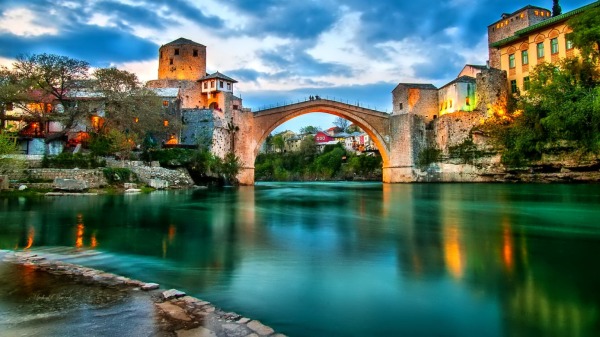Mostar is a special city in Bosnia and Herzegovina. Known for its beautiful medieval bridge that puts it on UNESCO’s map of World Heritage sites, it is located in the southern part of the country and is accessible from Croatia. This city, with its ancient architecture, also continues to show the effects of the military conflict that rocked the region in the 1990s and which destroyed the centuries-old bridge.
History
Mostar was a small settlement before the arrival of the Ottomans, under whom, during the 15th century, it developed into an administrative center where trade also thrived. After the fall of Ottoman rule, Mostar came under the auspices of the Austro-Hungarian Empire and European influences were introduced. In the 1990s, with the breakup of Yugoslavia and the start of the Bosnian War, Mostar was caught up in the conflict and many of its architectural treasures were destroyed.
Sights
Mostar’s old town contains the main share of sights and is small enough to get around on foot. Reconstruction of Old Mostar has taken place, so visitors can appreciate how this city looked in past centuries. Shops and cafes welcome guests to sip coffee or browse a variety of handmade items.
Stari Most: The Old Bridge, the guards of which gave Mostar its name, is an elegant single-arch bridge originally built in 1558. Flanked by towers, it stretches across the Neretva River. Reconstruction of the bridge took place in 2004, and though the current bridge is not the original, it remembers the majesty and architectural artistry of the first bridge. A museum about the bridge’s history is located near Stari Most—learn about its reconstruction and view excavations below the bridge.
Biscevica House: This house dates from the 17th century and is furnished as it was during Ottoman times. The courtyard is of particular interest with its numerical symbolism. For example, the fountain has twelve spouts for each month of the year.
Muslibegovic House: This 18th-century house, built in a traditional style with separate quarters for men and women for a family of wealthy standing, acts as a museum and guesthouse.
Karadozbegova Mosque: This Mosque is the most important mosque in the region. Though it suffered damage during the war, it has been reconstructed to present its 16th-century form.
Koski Mehmed Paša Mosque: Climb to the tower of this reconstructed mosque to get postcard-worthy views of the old town.
Old Hamam: This Ottoman-era public bath also contains exhibitions about Mostar’s recent history.
When Mostar came under Austro-Hungarian rule, those of other faiths were able to practice more freely. Along with mosques, Mostar is also home to various other houses of worship, including a Catholic church, an Orthodox church, and a Jewish synagogue. The Monastery in Zitomislici is located outside of Mostar, dates from the 16th century, and is open for visitors.
Getting to Mostar
Mostar is most active during the last spring and summer months. A visit to this World Heritage city during the off season may result in disappointment as attractions may be closed.
As best option we suggest you take a look at some of our premade tour offers, or create your own tour.
If you prefer to visit Mostar as an excursion, we suggest you to stay in Dubrovnik, Belgrade or Sarajevo. It is possible to arrange a day trip to Mostar from Croatia’s most-visited city, Belgrade spirited capitol of Serbia or Bosnia & Herzegovina main city Sarajevo. so if your schedule allows it, the benefit of a driver and a guide might be of good value.
Though an airport exists near Mostar, its flights are few. Trains also run from Mostar to Sarajevo, Zagreb, and Budapest.
 Balkan Incoming DMC Travel news, destinations and options in Balkan region
Balkan Incoming DMC Travel news, destinations and options in Balkan region



